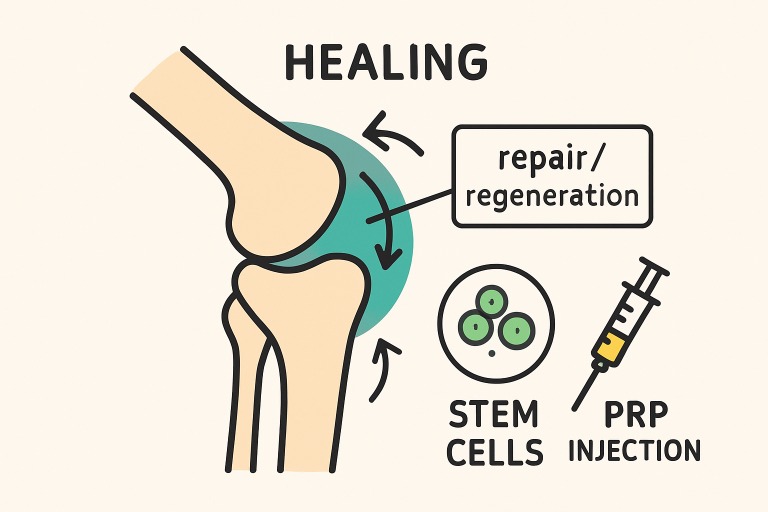Key Takeaways
- Regenerative medicine presents forward-thinking alternatives for individuals managing chronic pain, centering on healing rather than masking symptoms.
- Innovative techniques like stem cell therapy and platelet-rich plasma (PRP) are being implemented in medical practices with promising results.
- Continuous research, including studies from the National Institutes of Health, showcases the advancements and the need for further evidence.
- Emphasis on collaborative care and patient empowerment is essential for optimal outcomes and future advancements.
What Is Regenerative Medicine?
Regenerative medicine is revolutionizing chronic pain management by leveraging the body’s inherent ability to heal itself. Traditional pain management primarily focuses on symptom relief, but regenerative techniques encourage repairing and renewing damaged tissues. This fundamental shift has paved the way for treatment methods such as stem cell therapy, platelet-rich plasma injections, and tissue engineering that show particular promise for musculoskeletal and chronic pain conditions that once proved difficult to treat. For those seeking a non-surgical solution for pain, regenerative medicine offers a compelling alternative to more invasive options.
As clinical adoption grows, regenerative therapies change the conversation around chronic pain. Rather than relying solely on medications or surgery, more patients are working with their providers to harness treatments designed to spur the body’s healing processes. This proactive approach opens new possibilities, particularly for those with lingering pain that hasn’t responded well to traditional methods.
The Challenge of Chronic Pain
Chronic pain is a prevalent and complex health issue that affects millions worldwide, with a profound impact on daily living and quality of life. According to data from the Centers for Disease Control and Prevention (CDC), chronic pain is one of the most common reasons adults seek medical care. It is often a significant contributor to reduced mobility, anxiety, depression, and dependence on opioid or other pain medications. Given its widespread effect, identifying solutions that offer lasting relief without the shadow of side effects or dependency is a priority for patients and healthcare systems.
How Regenerative Therapies Differ from Traditional Treatments
The distinction between regenerative medicine and standard pain therapies lies primarily in their fundamental objectives. While conventional treatments, such as anti-inflammatory drugs, corticosteroid injections, or surgery, aim to suppress pain or remove damaged tissues, regenerative therapies work at the cellular level to rebuild or restore those tissues. For instance, stem cell therapy introduces specialized cells capable of renewal directly into injured areas, spurring the body’s repair processes. Similarly, PRP, produced from a patient’s blood, harnesses growth factors that naturally accelerate tissue healing. Early studies and patient experiences suggest that these methods may reduce the need for long-term medication use and help some individuals avoid or delay surgery.
What Current Research Reveals
There is an expanding foundation of clinical research exploring the efficacy of regenerative medicine for chronic pain. According to the Pain Research Forum, stem cell-based therapies have shown positive outcomes in treating osteoarthritis and degenerative disc disease. However, researchers note that more comprehensive and long-term studies are necessary to define which patient populations benefit the most and how risk can be minimized. The balance between optimism and scientific rigor will be crucial as evidence mounts.
Real-World Results and Patient Experiences
Patient stories about regenerative treatments illustrate a spectrum of outcomes. Some individuals report a significant reduction in pain, increased mobility, and overall improved function, often within weeks or months of therapy. For others, progress may be more modest, and outcomes can depend on factors such as the nature and progression of the injury, overall health, adherence to post-procedure care, and lifestyle. Integrating regenerative therapies as part of a holistic rehabilitation plan, which might include physical therapy and ongoing medical follow-up, tends to yield the most successful results. Information from Harvard Health Publishing affirms the value of a multidisciplinary approach to pain management.
Who Might Benefit from Regenerative Approaches?
Not every patient is a suitable candidate for regenerative medicine. Generally, individuals with mild to moderate joint degeneration, soft tissue injuries, or tendon/ligament problems may benefit the most. A thorough evaluation—ruling out contraindications such as active infections, certain cancers, or blood disorders—is vital before treatment. Medical professionals also consider the extent of tissue damage, age, overall health, and previous response to conservative care. In many cases, regenerative therapies provide a valuable opportunity to delay or even avoid the need for major surgical interventions.
Looking Ahead: The Future of Chronic Pain Care
The field of regenerative medicine is evolving rapidly, with ongoing innovations in both science and clinical application. Investigators are examining new sources and types of stem cells, enhanced delivery mechanisms, and the potential for synergistic combinations of regenerative agents. Improved protocols may result in more predictable and consistent outcomes, while technological advances could lower costs and increase accessibility. Transparent reporting, collaborative research, and robust clinical trials will shape best practices and support further widespread adoption.
Collaboration and Patient Empowerment
Effective chronic pain care is increasingly defined by trust and proactive communication between patients and their providers. Patients who equip themselves with reliable knowledge via publications such as Medical News Today play an active part in their recovery journey. The likelihood of successful outcomes improves when paired with clinicians dedicated to evidence-based, personalized care. As regenerative medicine advances, the collaborative partnership between patients, healthcare practitioners, and researchers will remain central to delivering meaningful, lasting pain relief.
Regenerative medicine offers new hope by addressing the root causes of chronic pain rather than masking symptoms. Patients gain pathways to long-term relief through innovative therapies that repair and restore damaged tissues. This forward-looking approach redefines treatment, empowering individuals with safer, more effective solutions for lasting quality of life.

